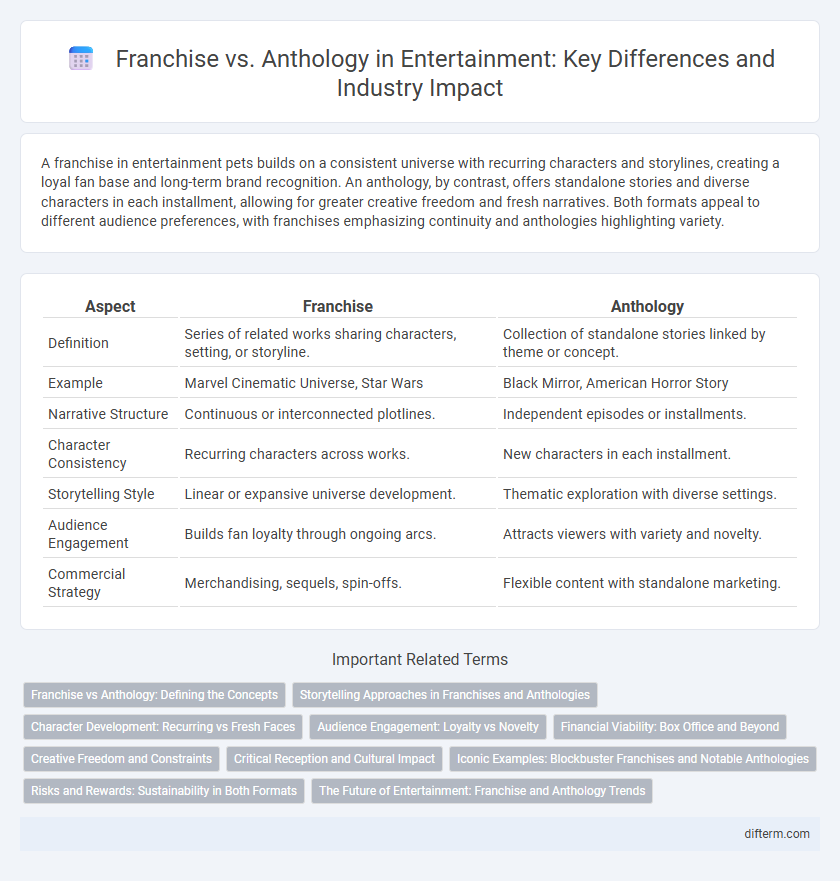A franchise in entertainment pets builds on a consistent universe with recurring characters and storylines, creating a loyal fan base and long-term brand recognition. An anthology, by contrast, offers standalone stories and diverse characters in each installment, allowing for greater creative freedom and fresh narratives. Both formats appeal to different audience preferences, with franchises emphasizing continuity and anthologies highlighting variety.
Table of Comparison
| Aspect | Franchise | Anthology |
|---|---|---|
| Definition | Series of related works sharing characters, setting, or storyline. | Collection of standalone stories linked by theme or concept. |
| Example | Marvel Cinematic Universe, Star Wars | Black Mirror, American Horror Story |
| Narrative Structure | Continuous or interconnected plotlines. | Independent episodes or installments. |
| Character Consistency | Recurring characters across works. | New characters in each installment. |
| Storytelling Style | Linear or expansive universe development. | Thematic exploration with diverse settings. |
| Audience Engagement | Builds fan loyalty through ongoing arcs. | Attracts viewers with variety and novelty. |
| Commercial Strategy | Merchandising, sequels, spin-offs. | Flexible content with standalone marketing. |
Franchise vs Anthology: Defining the Concepts
A franchise consists of multiple interconnected works, such as films, TV shows, or books, that share common characters, settings, and narratives, creating an expansive universe. An anthology features standalone stories united by a theme or genre, with each installment presenting unique plots and characters without narrative continuity. Understanding franchise versus anthology is crucial for entertainment creators and audiences seeking cohesive storytelling or diverse, independent narratives.
Storytelling Approaches in Franchises and Anthologies
Franchises utilize interconnected narratives spanning multiple installments, creating a cohesive universe that deepens character development and audience engagement through continuity. Anthologies present standalone stories with distinct settings and characters, offering creative flexibility while exploring diverse themes and genres within a unified framework. This storytelling approach influences viewer expectations and emotional investment, shaping the overall consumption experience in entertainment media.
Character Development: Recurring vs Fresh Faces
Franchise series emphasize deep character development through recurring characters, allowing audiences to form long-term emotional connections and witness growth over multiple installments. In contrast, anthology formats introduce fresh faces in each installment, offering diverse character arcs without the constraints of previous narratives. This approach provides creative flexibility but may limit the emotional investment typically fostered by ongoing character continuity.
Audience Engagement: Loyalty vs Novelty
Franchise entertainment cultivates audience loyalty by developing familiar characters and consistent storylines that encourage long-term fan investment, enhancing brand recognition and repeat viewership. Anthologies prioritize novelty, delivering fresh plots and unique settings in each installment, which attracts viewers seeking diverse and varied experiences without commitment to a single narrative arc. Both formats effectively engage audiences by balancing predictability and innovation to satisfy different viewer preferences and maintain sustained interest.
Financial Viability: Box Office and Beyond
Franchise films often generate higher box office revenue due to established fan bases and ongoing storylines that encourage repeat viewership and merchandise sales. Anthologies provide financial flexibility by attracting diverse audiences with standalone stories, reducing risk if one installment underperforms. Both models expand revenue streams through digital rights, streaming platforms, and international markets, but franchises typically yield more consistent long-term financial returns.
Creative Freedom and Constraints
Franchise productions often face creative constraints due to established lore, character continuity, and fan expectations, which can limit storytelling innovation. Anthologies offer greater creative freedom by allowing unique narratives and styles in each installment without adherence to a fixed universe or recurring characters. This flexibility in anthologies fosters experimentation and diverse artistic expression, contrasting with the structured framework franchises typically maintain.
Critical Reception and Cultural Impact
Franchise entertainment often achieves widespread critical acclaim through consistent storytelling and character development, fostering strong fan loyalty and significant box office success. Anthologies, favored for their creative freedom and thematic diversity, attract critical praise for innovation but may struggle with maintaining a cohesive cultural presence. Both formats influence pop culture differently: franchises build enduring universes with expansive merchandising, while anthologies push artistic boundaries and provoke varied societal conversations.
Iconic Examples: Blockbuster Franchises and Notable Anthologies
Blockbuster franchises like the Marvel Cinematic Universe and Harry Potter dominate the entertainment industry by creating expansive, interconnected storylines across multiple films and media. Notable anthologies such as Black Mirror and American Horror Story offer standalone episodes or seasons that explore diverse themes and characters within a unified conceptual framework. Franchises build long-term fan investment through recurring narratives, while anthologies provide creative flexibility and thematic exploration.
Risks and Rewards: Sustainability in Both Formats
Franchise formats offer sustainable brand recognition and long-term revenue through recurring characters and storylines but face risks of creative stagnation and audience fatigue. Anthologies provide creative flexibility and innovation by telling diverse, self-contained stories each season or installment, yet they struggle with building a loyal, returning fanbase. Balancing consistent engagement with freshness determines sustainability success in both entertainment formats.
The Future of Entertainment: Franchise and Anthology Trends
Franchise entertainment continues to dominate global markets with blockbuster series like Marvel and Star Wars generating sustained revenue through interconnected storylines and extensive merchandising. Anthology formats, seen in series such as Black Mirror and American Horror Story, offer creative flexibility by exploring diverse narratives within a shared thematic framework, appealing to viewers seeking variety and innovation. Emerging trends indicate a hybrid approach, where studios blend franchise loyalty with anthology freshness, leveraging streaming platforms to expand audience engagement and maximize content longevity.
franchise vs anthology Infographic

 difterm.com
difterm.com